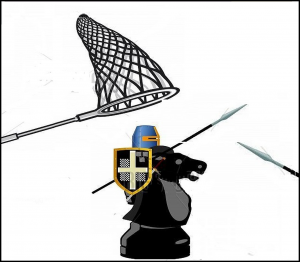How to Trap a Workplace ‘Black Knight’ Who’s Out to Get You

Those traps include ones set by the “Black Knight” adversary and those of the good guy’s own making—the “good guy” being the much more ethical, reasonable, responsible and blameless.
What remains to be examined is how the White Knight can not only avoid falling into traps, but also how he can trap a Black Knight.
Trapping a Black Knight is the second critical prong of a White Knight effective coping strategy, especially when any delay in ending or otherwise resolving the conflict is likely to cost the organization and/or the White Knight dearly. In this connection, general abstract advice—without regard for the concrete details of the tussle—can, like abstract game theory, scientific principles and moral rules, provide very useful guidance.
In particular and in this instance, such analysis can pay off big-time with regard to dealing with a workplace bad guy out to get you, e.g., get you fired, demoted, ostracized, marginalized, stripped of power or authority, or otherwise make your life Hell.
So, despite any sense of helplessness or dread in facing a workplace Black Knight and reluctance to face up to the virtual certainty that his campaign against you (if you are a White Knight) won’t end until one of you is finished, it is imperative that you know your strategic and tactical options.
How (Not) to Retaliate Against a Black Knight
What can a White Knight good guy do, besides avoiding the Black Knight’s traps? “On the Exchange of Hostility with Supervisors: an Examination of Self-Enhancing and Self-Defeating Perspectives” —published January 2014 in the journal Personnel Psychology—suggests that employee “retaliation” against “hostile” bosses in the form of passive-aggressively ignoring them, not giving a full effort, etc., can dampen the adverse impacts of employee victimization by supervisors.
Led by Bennett Tepper (Fisher College of Business, Ohio State University), the research suggested that “upward hostility weakens the deleterious effects of downward hostility on subordinates’ job satisfaction, affective commitment, and psychological distress.”
However, to the extent that passive-aggressive behavior, e.g., pretending one doesn’t understand what the boss is ranting about, does or doesn’t count as “retaliation”, common sense suggests that employees should exercise extreme caution in contemplating tit-for-tat literal retaliation, e.g., in the form of screaming back at the Black Knight supervisor.
How to Trap a Black Knight
Although retaliating may, in the short run, feel good, it obviously can be risky. Here are some options that will facilitate trapping a Black Knight, while in all likelihood being safer than full retaliation:
1.UTILIZE A “NATURAL CONSEQUENCES” APPROACH: From the perspective of Dr. William Glasser’s “Reality Therapy” —a choice-focused model for psychiatric treatment and behavioral management of adults and children, one of the most effective ways to modify another’s bad behavior is to refrain from tit-for-tat retaliatory punishment and not even use re-motivating personally administered rewards, but to, instead, allow “nature” to inflict the punishment for bad choices, while equally natural rewards are simultaneously dangled as the alternative.
I recall my first exposure to the principle while on a tour of an Ontario, Canada psychiatric treatment facility for kids with issues (including bad parents). One of them had smashed his bedroom window and had to be dealt with, but not punitively nor with bribes or other staff-administered incentives.
Instead, and very cleverly, he was told that since he broke the window in the dead of a freezing Ontario winter, he would, as a natural consequence, have very, very chilly bedtimes, until and unless he repaired the window himself or at least covered the cost of replacement (e.g., through paid chores).
Employing the widely-endorsed Glasser technique with well thought-out deliberation, the facility’s staff had nipped this budding Black Knight’s antics in the bud by not only making him see the natural consequence of his behavior, but also—brilliantly–positively empower him by engaging him in a positive accomplishment through application of skill (in managing the process of improving his own space) and cultivation of a sense of responsibility.
The reason this a natural reward’s-based approach is that the boy enjoyed prevention or relief from chills as his reward for constructive, proactive, skilled and responsible, responsive effort, without any staff-administered punishment or reward, since all the reward and punishment scenarios were controlled by Mother Nature and himself. (He was indeed a Black Knight in the making because of his varied and persistent efforts to sabotage and ambush staff, e.g., with a pot of tossed boiling water.)
The natural consequences approach can be applied with equal relevance and success in purely adult workplaces. For example, if the Black Knight’s tactics include passive-aggressive obstruction of a White Knight’s work, the latter need only identify the natural negative consequences and costs to his job performance and, by implication, for the company and “naturally” file a report to supervisors or others with the power to get things moving smoothly again.
Of course, it would be better to merely point out to the Black Knight that, unless he backs off, the natural consequences will include damage to the organization that will have to “somehow” be accounted for.
What makes this a useful trap is the option of allowing the Black Knight to persist in his obstructionism just long enough to prove it exists, that it is damaging and, in effect, to “hoist himself by his own petards”, as the expression puts it.
It can also be constructively therapeutic in the same way it was at the children’s facility: Making the Black Knight aware of the remote as well as immediate natural consequences may trigger awareness of responsibility and risk, and thereby induce abandonment of the passive-aggressive tactic, if not a change of heart and aims, without any White Knight personally administered punishment as retaliation or deterrent.
2. CREATE DOCUMENTATION: It may be possible to trap a Black Knight by creating an evidential, documented trail of his behavior. This means replacing as much of the “he said-I said”, unprovable exchanges with the bad guy with lawful digital, paper or otherwise recorded evidence of what he is up to. Setting the trap means, for example, making it clear in writing that you have grave reservations about taking what you perceive as self-destructive or organizationally damaging actions being forced or urged upon you by the Black Knight. Never relegate such crucial communications to purely oral, unwitnessed forms.
Such documentation will be invaluable in three ways: First, it will serve notice that the bad-boy harmful tactics are recognized and are being exposed as such (and thereby exonerate you, while implicating him, if necessary); second, it will generally utilize channels, e.g., email, that encourage more thoughtful, circumspect reflection than spontaneous hot and inflammatory unwitnessed vocal confrontations do (thereby increasing the odds of rational and fair resolution); third, the documentation can serve as evidence, in the event 3rd-parties get involved through “triangulation” (discussed next).
3. TRIANGULATE: As I argued in “Triangulation of Conflict: the Smart Way to Deal with Problem People”, triangulating a conflict is a powerful technique for conflict management and resolution. It has various forms, one of which is to redirect a Black Knight’s hostility and defensiveness toward a common enemy—a “tertium quid” (Latin: a 3rd thing or element) that can transform an enemy (in-the-making) into an ally united in common cause. Although this per se is not a trap, it can be transformed into one under certain circumstances, illustrated after the following presentation of the general case.
If a co-worker is hostile toward you because of the frustration, annoyance and inconvenience created by your legitimate needs, sympathetically acknowledging his or her stress while attributing it to the heavy workload (s)he is burdened with or to lack of deserved resources will triangulate the conflict by identifying workload and resource insufficiency as the real tertium-quid culprit and apex of the now triangulated problem.
Even if nothing can be done about the workload or resources, at least your co-worker’s anger and frustration may be redirected away from you, in virtue of your sympathy, respect and “helpfulness” in identify the real trouble-making element(s). In other instances, identification of the tertium quid can result in successful conflict resolution, e.g., when your stressed-out coworker successfully appeals for additional resources and more streamlined workload.
Variations on non-trap, “collegial” triangulation can be used effectively as a Black Knight trap in at least two ways:
—GET THE KING IN PLAY: When I was Editor-in-chief of hard-copy and cyberzine Business Insight Japan Magazine, the publisher wanted a pre-launch letter of support from the American embassy in Tokyo, which we politely requested. Unfortunately, the rank-and-file staffer dealing with it seemed to be passively-aggressively stone-walling us, despite repeat, shrugged-off, eventually urgent requests.
My proposed solution was to triangulate our White Knight-Black Knight conflict by “getting the King in play”, by simply cc-ing a higher-rank embassy official.
What had taken weeks was accomplished within minutes: We got a glowing letter of support as an endorsement, photo-copied and published in our 1998 inaugural issue of the magazine (which has since ceased publication).
—RECRUIT A DOUBLE AGENT: Induce the Black Knight to cc or otherwise involve someone he thinks will be an ally, but in fact is anything but—being at best, from the Black Knight’s strategic standpoint or in fact, merely neutral, and, at worst, your ally.
This may be easier to pull off than you may imagine. For example, anticipating a Black Knight move to recruit the tertium-quid player, you preemptively apprise and groom the “double agent”, and gain the double advantage of not only being able to frame the conflict narrative, but also to do it first.
When the Black Knight sallies forth to do you in by forging an alliance with the double agent, instead of gathering support, there’s a good chance he will unwittingly confirm your narrative by having the Black Knight version reframed as yours by the double agent (especially if you are demonstrably in the right).
Given the array of traps that can be set for a maneuvering, nasty workplace Black Knight, there’s bound to be a workable counter-attack a White Knight can mount. But what do you do if you cannot set a trap and are also unable to otherwise defend yourself in ways I suggested in “When and Why the Good Guy Quits the Company First” ?
Since literal trials-by-combat, duels and jousting are out, and a challenge to a fair coin toss unlikely to be accepted, there may be only one thing left to do.
…Whatever and the best you can, by hook or by rook.

